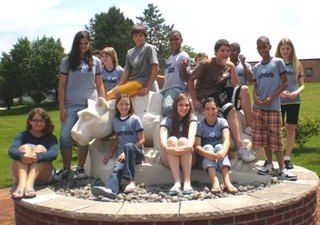Penn State Worthington Scranton gave a whole new meaning to 'summer camp' this year with a series of technology-oriented academies aimed at teaching area youth some creative ways to use technology.
From creating animations to composing music, students attending the Nittany Cub Camps and Academies at Penn State Worthington Scranton learned new skills while also having fun. And, it is hoped that as a result of their summer experience, they will have a new and stronger interest in science, math and technology both in school and as a potential career path.
The STEM Summer Academy, which was one of the first courses offered, was a week-long program for students ages 13 to 15. It connects students and teachers with ongoing interdisciplinary programs and provides them with science, technology, engineering and math experiences. Students and teachers collect and analyze data that will be used by the teachers in their research projects.
STEM research projects involve major concepts in earth, physical and biological sciences as well as significant ideas in engineering and technology. Graphing, analyzing and interpreting data help develop math skills and support in-school curricula. The program also features on-line resources and career awareness activities.
The goals of the Academy are to increase career interest in the sciences, highlight knowledge of science content and technology in the real world, develop partnership among students and motivate students in science and math.
Over 20 youths participated in the summer program offered at Penn State Worthington Scranton for the first time this year, thanks in part to funding from a state Educational Improvement Tax Credit (EITC) grant that provided full scholarships for the students.
Sandy Feather, associate director of admissions at the campus and an organizer of the STEM program, said the STEM Summer Academy was very well-received and has already been funded for Summer 2010.
In line with the STEM Summer Academy, Penn State Worthington Scranton has developed several other unique courses that touch on contemporary technology topics while also tapping into students' imaginations and creativity.
Fred Aebli, an information sciences and technology instructor at the campus who taught Creating Animations, a Nittany Cub Camp, said 20 children aged 8 to 12, took his course. The students worked together to create animated stories using a flip book technique and their imaginations.
"This particular course is all about the thought process," Aebli explained. "They're actually learning the basics of programming in a fun way," he said. "It's a way to familiarize them with technological applications they haven't worked with yet. All they know is that they're having fun being creative and working in teams."
While Aebli's students were using their imaginations to create stories and animated characters, Sharon Toman, senior instructor of music, was teaching the Music and Technology Academy where students were learning to arrange and compose digital music using Sibelius software.
"My course was geared toward students who already had a basic understanding of music notation and could read music," Toman explained. She taught students a bit of music theory before they started using the Sibelius software to compose their own digital pieces.
"This software is changing the face of music," she said. "It's a new tool for all musicians and allows users to create pieces that can range from that of a symphony orchestra to a rock band. And, it provides instant results."
By the end of Toman's course, each student had composed several orchestrated musical scores which they demonstrated via visual and audio playback for the class and their parents who were in attendance.
Dr. Debra Smarkusky, associate professor of information sciences and technology at Penn State Worthington Scranton, was also involved with the summer academies.
Her course, Creating 3-D Software Animations Academy, also combined technology and music, teaching students how to design and develop their own animations with music using Alice software. Students were able to use this cutting-edge software to manipulate objects in a virtual world and to add their own sound effects and background music.
It was a course that tapped into students' interest in technology, as well as their artistic side, she explained.
"While music and software animation may appear to be completely different, they actually work very well together, because composing music follows the same process as developing a software application," Dr. Smarkusky stated.
"Today's students are getting savvier in the use of computers and software," Aebli said. "They have a much greater knowledge and comfort level than students had even just a few years ago, but they still like to have fun."
In fact, combining technology with fun, creativity and young imaginations was an underlying theme and goal of this summer's youth technology offerings at Penn State Worthington Scranton and something that Aebli, Smarkusky and Toman are very much interested in encouraging, enhancing and continuing.
